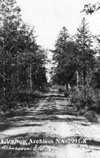![]() Bugs, Mud, and Freight
Bugs, Mud, and Freight

| Newton Egge's "Stopping House," halfway between Edmonton and Athabasca Landing (built 1896). |
A fair road some hundred miles in length has been made by the Hudson's Bay Company through a rolling sandy country, crossing several large streams and passing through a good deal of thick pine timber where some heavy chopping must have been necessary . . . There were no houses along the road, but plenty of firewood and feed for the horses; we had a good camp every night, sleeping in the open air, starting very early and resting long in the middle of the day . . . [E]arly on the fourth day we came in sight of Athabasca, running between high pine-clad banks . . . This spot is known as the Athabasca landing, and consists of a large depot for goods, trading-store, and several workmen's houses, while the house of the officer in charge stands on the hillside a little way back from the river. (Athabasca Historical Society 1986, 34)
|
|
Interview clip with C.J. Raynor Whitely, about starting a stopping place on the Landing Trail in 1900. Athabasca Archives, audio tape #8, accession #85.285. |
Freighting was a big business . . . The roads and trails during the busy seasons would be occupied by scores of teams going and coming . . . Many of the stopping places consisted of a fair size shack equipped with a stove, which provided welcome warmth during the winter. After stabling our horses we would go into this shack and cook our own meal, then roll our blankets on the floor and got to sleep. We were on the road before daybreak. At noon we usually stopped at any convenient place along the way, gave our horses a feed of grain . . . and ate our lunch which not infrequently was frozen.Each freighter usually operated two two-horse teams and two sleighs. It was considered a much better practice to distribute the loads over two sleighs hauled by a team each than to overload one sleigh hauled by four horses. By the former method the roads were protected and maintained in better condition throughout the winter. Heavy freighting was usually done during the winter when the ground was frozen and the ice on the rivers and lakes could be utilized. (Athabasca Historical Society 1986, 43-44)
Home | Hudson's Bay Company Post | The Landing Trail | Society, Gender, and Race | Transportation Hub | Boatbuilding | To the Klondike | The Commercial Boom | Amber Valley | The Athabasca Bore | Agriculture and Settlement | Then and Now












